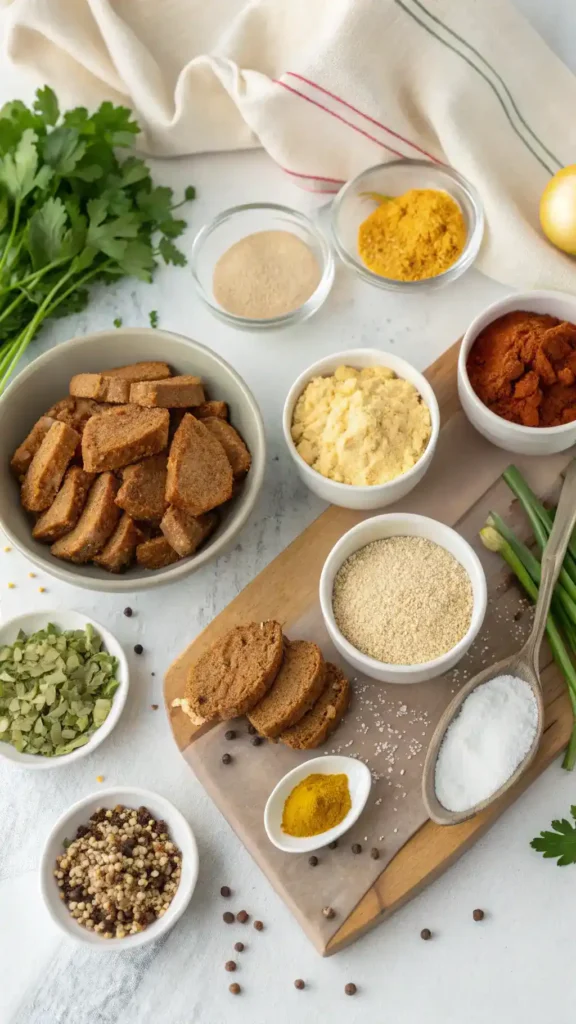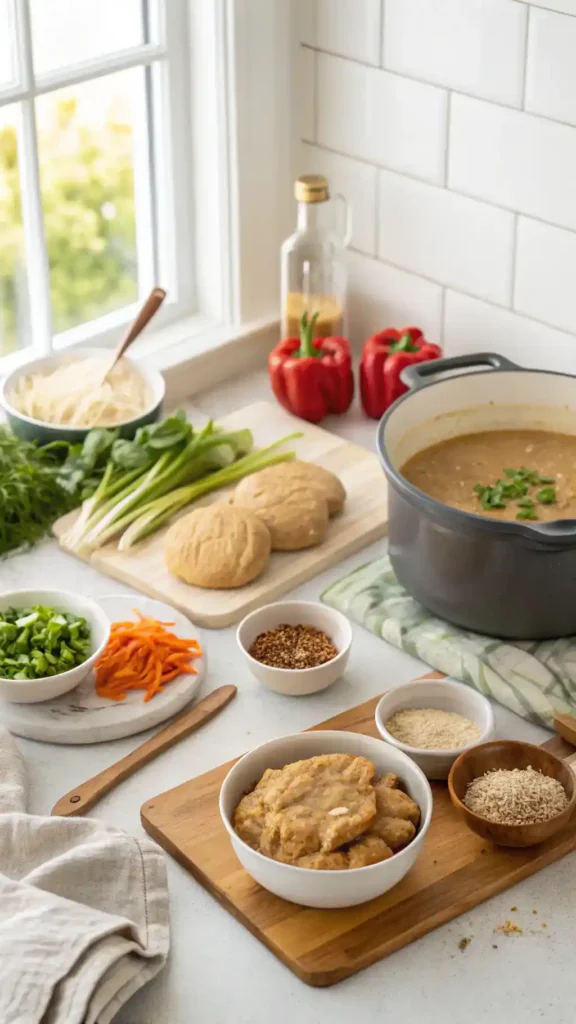Have you ever wondered how to make seitan, the incredible plant-based protein that has taken the culinary world by storm? This versatile meat substitute is not only a staple in vegan diets but also a fantastic way to incorporate more high-fiber, low-fat options into your meals. In fact, seitan is made from vital wheat gluten, which means it’s gluten-rich and packed with nutritional value. Whether you’re a seasoned chef or a curious beginner, this complete guide will walk you through the process of making seitan from scratch, ensuring that you can enjoy its health benefits and culinary versatility. So, let’s dive in and explore how to make seitan that’s not only delicious but also tailored to your taste preferences!

how to make seitan
Equipment
- 1 Mixing bowl For combining dry ingredients.
- 1 Pot For cooking the seitan.
- 1 Clean Surface For kneading the dough.
Ingredients
Dry Ingredients
- 1 cup Vital Wheat Gluten Main ingredient for seitan.
- 3/4 cup Water or Vegetable Broth For hydrating the gluten.
Seasonings
- to taste Garlic Powder Optional seasoning.
- to taste Smoked Paprika Optional seasoning.
- optional Nutritional Yeast Adds flavor and nutrients.
- to taste Vegetable Broth For boiling the seitan.
Instructions
Preparation
- Gather your ingredients: vital wheat gluten, water, and seasonings of your choice.
Mixing
- In a large mixing bowl, combine the vital wheat gluten with your chosen seasonings.
Adding Liquid
- Gradually pour in the water or vegetable broth and stir until it forms a dough.
Kneading
- Knead the dough on a clean surface for about 5-10 minutes.
Shaping
- Shape the dough into a log or divide it into smaller pieces.
Cooking Liquid
- In a large pot, combine water or vegetable broth with additional seasonings and bring to a simmer.
Cooking
- Place the shaped seitan into the simmering liquid and cook for 30-40 minutes.
Cooling
- Remove the seitan from the pot and let it cool before using or storing.
Video
Notes
Table of Contents
Key Benefits of Making Seitan
When you learn how to make seitan, you’re opening the door to a world of culinary possibilities! This versatile ingredient is not only a fantastic meat substitute but also packed with health benefits. Here are some reasons to give it a try:
- Rich in Plant-Based Protein: Seitan is an excellent source of protein, making it a perfect choice for those on a vegan diet. In fact, it contains about 25 grams of protein per 3.5 ounces!
- Low in Fat: Unlike many meat products, seitan is low in fat, which can help you maintain a healthy diet without sacrificing flavor.
- High in Fiber: While seitan is primarily made from gluten, it can also be combined with other ingredients to boost its fiber content, promoting digestive health.
- Customizable Flavor: One of the best parts about learning how to make seitan is that you can infuse it with your favorite spices and seasonings. This means you can create a dish that perfectly suits your taste!
- Sustainable Food Source: Seitan is made from wheat, which is a more sustainable option compared to many animal proteins. By choosing seitan, you’re making a positive impact on the environment.
In summary, making seitan not only enhances your cooking experience but also supports your health and dietary choices. So, why not give it a go? You might just discover your new favorite ingredient!
Ingredients for Making Seitan
Making seitan is a delightful journey into the world of plant-based cooking. To get started, you’ll need a few key ingredients that are not only simple but also essential for crafting this versatile meat substitute. Here’s what you’ll need:
- Vital Wheat Gluten: This is the star of the show! It’s the main ingredient that gives seitan its chewy texture. Look for high-quality vital wheat gluten, as it will significantly impact the final product.
- Water: A simple yet crucial component. The water helps to hydrate the gluten, allowing it to develop that wonderful texture. You can also use vegetable broth for added flavor.
- Seasonings: This is where you can get creative! Consider adding garlic powder, onion powder, or smoked paprika to enhance the flavor. Don’t be afraid to experiment with your favorite spices.
- Nutritional Yeast: This ingredient is optional but highly recommended. It adds a cheesy, umami flavor that elevates your seitan. Plus, it’s packed with nutrients!
- Vegetable Broth: If you want to infuse your seitan with more flavor, use vegetable broth instead of water for boiling. This will give your seitan a delicious base.

When selecting your ingredients, aim for the freshest options available. For instance, organic vital wheat gluten can provide a better texture and taste. Additionally, if you’re gluten-sensitive or looking for alternatives, consider using tofu or tempeh instead. However, if you’re ready to dive into making seitan, these ingredients will set you on the right path. Remember, the quality of your ingredients can make all the difference in how to make seitan that’s not only delicious but also satisfying!
How to Make Seitan
Making seitan at home is not only rewarding but also a fantastic way to incorporate a high-protein, plant-based meat substitute into your meals. Follow this step-by-step guide to learn how to make seitan from scratch, ensuring you achieve the perfect texture and flavor every time.
- Gather Your Ingredients: You will need vital wheat gluten, water, and seasonings of your choice. For a flavorful base, consider using vegetable broth, nutritional yeast, and spices like garlic powder or smoked paprika. Having everything ready will make the process smoother.
- Mix the Dry Ingredients: In a large mixing bowl, combine 1 cup of vital wheat gluten with your chosen seasonings. This is where you can get creative! For instance, adding nutritional yeast will enhance the flavor and nutritional value.
- Add Water: Gradually pour in about 3/4 cup of water or vegetable broth. Stir the mixture until it forms a dough. If the dough feels too dry, add a little more liquid. Conversely, if it’s too wet, sprinkle in a bit more vital wheat gluten.
- Knead the Dough: Transfer the dough to a clean surface and knead it for about 5-10 minutes. This step is crucial because it develops the gluten, giving seitan its chewy texture. If you notice the dough is too sticky, dust your hands with a bit of vital wheat gluten.
- Shape the Seitan: Once kneaded, shape the dough into a log or divide it into smaller pieces, depending on how you plan to use it. Remember, the size will affect cooking time, so keep that in mind!
- Prepare the Cooking Liquid: In a large pot, combine water or vegetable broth with additional seasonings. You can add soy sauce, garlic, and herbs for extra flavor. Bring this mixture to a gentle simmer.
- Cook the Seitan: Carefully place the shaped seitan into the simmering liquid. Cover the pot and let it cook for about 30-40 minutes. During this time, the seitan will expand and absorb the flavors. Make sure to check occasionally to ensure it’s not boiling too vigorously.
- Cool and Store: Once cooked, remove the seitan from the pot and let it cool. You can use it immediately or store it in the fridge for up to a week. For longer storage, consider freezing it in portions.

By following these steps on how to make seitan, you’ll create a delicious and versatile meat substitute that can be used in a variety of dishes. Enjoy experimenting with flavors and textures as you incorporate this fantastic ingredient into your plant-based meals!
Pro Tips, Variations, and Common Problems
Making seitan can be a delightful culinary adventure, but it’s not without its challenges. Here are some pro tips and variations to help you master how to make seitan, along with solutions to common problems you might encounter.
Pro Tips for Perfect Seitan
– Knead Well: Kneading the dough is crucial. Aim for about 5-10 minutes to develop the gluten properly. This step enhances the texture, making it chewy and meat-like.
– Flavor Infusion: To elevate the taste, consider adding spices or herbs directly into the dough. Garlic powder, onion powder, or smoked paprika work wonders. Additionally, using vegetable broth instead of water can add depth to the flavor.
– Cooking Methods: Experiment with different cooking methods. While boiling is common, steaming or baking can yield different textures. For instance, steaming can create a firmer seitan, while baking can give it a nice crust.
Creative Variations
– BBQ Seitan: Mix in BBQ sauce into the dough for a smoky flavor. After cooking, brush more sauce on top for a delicious glaze.
– Asian-Inspired: Incorporate soy sauce, ginger, and sesame oil into the dough for an Asian twist. This variation is perfect for stir-fries or as a filling in bao buns.
– Herbed Seitan: Add fresh herbs like thyme or rosemary for a fragrant touch. This variation pairs beautifully with roasted vegetables.
Troubleshooting Common Problems
– Rubbery Texture: If your seitan turns out rubbery, it’s likely due to over-kneading or overcooking. To avoid this, knead just until the dough is elastic and cook it gently. A simmering broth is ideal.
– Bland Flavor: If your seitan lacks flavor, don’t hesitate to season generously. Remember, seitan absorbs flavors well, so marinating it in a flavorful sauce can enhance its taste significantly.
– Storage Issues: To keep your seitan fresh, store it in an airtight container in the fridge for up to a week. Alternatively, you can freeze it for longer storage. Just make sure to slice it before freezing for easy use later.
By following these tips and variations, you’ll be well on your way to mastering how to make seitan. Remember, practice makes perfect, so don’t hesitate to experiment and find what works best for you!
Serving Suggestions for Seitan
Now that you know how to make seitan, it’s time to explore some delightful serving suggestions that will elevate your dish. Whether you’re hosting a casual get-together or a fancy dinner, these ideas will help you impress your guests and make the most of this versatile meat substitute.
Plating Ideas
When it comes to plating seitan, presentation is key. Here are some tips to make your dish visually appealing:
- Use a large, colorful plate to create a striking contrast with the seitan. A white plate can make the dish pop, especially if you add vibrant sides.
- Slice the seitan into thin strips or cubes for a more elegant presentation. Arrange them artfully on the plate, perhaps in a fan shape.
- Garnish with fresh herbs like parsley or cilantro. Not only does this add a splash of color, but it also enhances the flavor.
Side Dish Pairings
To complement your seitan, consider these delicious side dishes:
- Serve it alongside a refreshing salad, such as a quinoa salad with cherry tomatoes and cucumber. This adds a light, healthy touch.
- Pair seitan with roasted vegetables, like carrots and bell peppers, for a hearty, colorful plate.
- For a comforting option, consider mashed potatoes or creamy polenta. These sides provide a lovely contrast to the chewy texture of seitan.
Creative Serving Options
There are countless ways to serve seitan, depending on the occasion:
- For a casual meal, try making seitan wraps. Fill whole-grain tortillas with seitan, avocado, and fresh veggies for a satisfying lunch.
- If you’re aiming for an elegant dinner, serve seitan in a rich mushroom sauce over a bed of wild rice. This creates a gourmet experience.
- For family-style dining, present a large platter of seitan stir-fry with colorful vegetables. This encourages sharing and adds a fun, communal vibe.
Ultimately, how you serve seitan can transform your meal. So, don’t hesitate to get creative and experiment with different cuisines and flavor profiles. Whether you’re preparing a simple weeknight dinner or an elaborate feast, these serving suggestions will help you showcase your homemade seitan beautifully!
Preserving and Reheating Seitan
Storing seitan properly is essential for maintaining its flavor, texture, and overall quality. First and foremost, if you plan to enjoy your homemade seitan later, refrigerate it in an airtight container. This method keeps it fresh for about 5 to 7 days. Alternatively, for longer storage, consider freezing your seitan. When frozen, it can last up to 3 months without losing its delightful taste. To freeze, wrap the seitan tightly in plastic wrap or place it in a vacuum-sealed bag, ensuring all air is removed. This step is crucial because it prevents freezer burn, which can ruin the texture.
Moreover, always label your containers with the date. This practice helps you keep track of freshness. When it comes to food safety, remember to check for any signs of spoilage, such as off smells or unusual textures. If you notice anything suspicious, it’s best to err on the side of caution and discard it.
Reheating Methods
Now, let’s talk about reheating your seitan to ensure it remains delicious and tender. One of the best methods is using the stovetop. Simply slice your seitan and heat it in a skillet over medium heat. Add a splash of vegetable broth or water to keep it moist. Stir occasionally for about 5 to 7 minutes until heated through. This method not only warms the seitan but also enhances its flavor.
If you prefer the oven, preheat it to 350°F (175°C). Place your seitan in a baking dish, cover it with foil, and add a little vegetable broth to maintain moisture. Bake for about 15 to 20 minutes, checking occasionally to ensure it doesn’t dry out. This method is particularly great for larger pieces or when you want to reheat a batch for a meal.
For a quick option, the microwave works too. Place your seitan in a microwave-safe dish, add a splash of water, and cover it with a microwave-safe lid or wrap. Heat it in short bursts of 30 seconds, stirring in between, until it’s warmed to your liking. However, be cautious, as microwaving can sometimes lead to a rubbery texture if overdone.
Lastly, if you have an air fryer, this can be a fantastic way to reheat seitan while keeping it crispy. Preheat the air fryer to 350°F (175°C), place the seitan in the basket, and heat for about 5 to 7 minutes. This method gives your seitan a delightful texture, making it perfect for sandwiches or salads.
In summary, whether you choose to store your seitan in the fridge or freezer, and whichever reheating method you prefer, following these tips will ensure that your homemade seitan remains a flavorful and satisfying addition to your meals. Enjoy your culinary creations!
Conclusion
In summary, making seitan is a straightforward and rewarding process that highlights the beauty of plant-based cooking. By combining vital wheat gluten with water and your choice of seasonings, you can create a versatile meat substitute that is not only rich in protein but also low in fat and high in fiber. This recipe allows you to explore various flavors and textures, making it an excellent choice for anyone looking to enhance their vegan diet. So, whether you’re preparing a hearty stir-fry or crafting delicious sandwiches, seitan can easily adapt to your culinary needs.
As you embark on your seitan-making journey, I encourage you to share your results or ask any questions you might have. Cooking is all about experimentation, so feel free to try different spices or cooking methods to find what suits your taste best. Remember, the kitchen is a place for creativity and joy, and learning how to make seitan is just the beginning of your culinary adventure. Enjoy the process, and happy cooking!
Frequently Asked Questions About Making Seitan
Curious about how to make seitan? You’re not alone! Here are some common questions and helpful answers to guide you through the process.
1. What is seitan made of?
Seitan is primarily made from vital wheat gluten, which is the protein found in wheat. To make it, you mix vital wheat gluten with water and seasonings. You can also add vegetable broth or spices for extra flavor. This combination creates a dough that can be kneaded and cooked to achieve a meat-like texture.
2. How do I store homemade seitan?
To store homemade seitan, keep it in an airtight container in the refrigerator for up to a week. If you want to keep it longer, you can freeze it. Just make sure to wrap it tightly in plastic wrap or a freezer-safe bag. When you’re ready to use it, thaw it in the refrigerator overnight.
3. Why is my seitan rubbery?
If your seitan turns out rubbery, it might be due to over-kneading or cooking it for too long. To avoid this, knead the dough just until it’s combined and has a slightly elastic texture. Additionally, try simmering it gently rather than boiling it vigorously. This will help achieve a tender result.
4. Can I flavor seitan while making it?
Absolutely! You can enhance the flavor of your seitan by adding spices, herbs, or even nutritional yeast to the dough. Furthermore, marinating the cooked seitan in your favorite sauces can also boost its taste. Experiment with different flavors to find what you love!
5. How does seitan compare to tofu?
Seitan and tofu are both excellent plant-based protein sources, but they have different textures and flavors. Seitan has a chewy, meat-like texture, making it a great meat substitute in savory dishes. On the other hand, tofu is softer and absorbs flavors well, making it versatile in both sweet and savory recipes. Depending on your dish, you can choose one over the other or even use them together!

